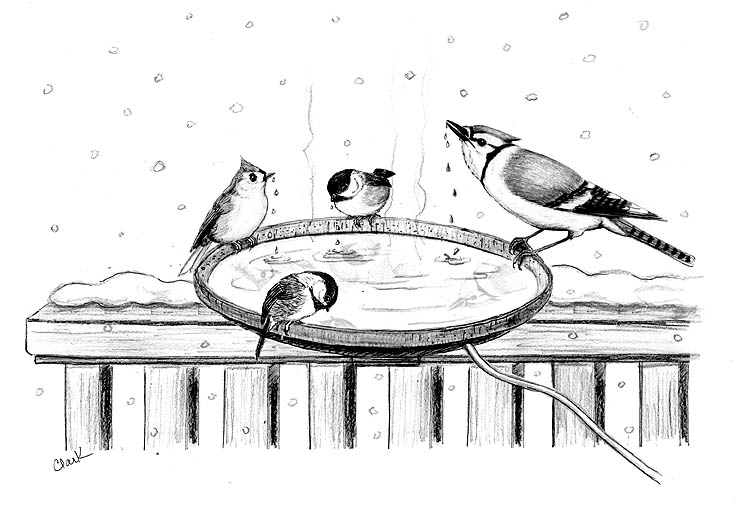
Dear Bird Folks,
For the past month, I’ve been dropping hints about wanting a heated birdbath for Christmas. Apparently, I’m not very good at hinting. On Christmas morning I ended up with a lot of thoughtful gifts, but alas, no heated birdbath. Now I have to go out and buy my own. Do you have any recommendations?
– Ted, Bennington, VT
I feel your pain, Ted,
I only asked for two things this year: a pair of non-leather gloves and my own private island in the Caribbean, and received neither. And I have been extra good this year, too. Oh, well. However, I did end up with a nice gift card to Radio Shack. I can’t wait to use it.
Some folks scoff at the idea of a heated birdbath. They consider it to be the ultimate in bird opulence. But a dish of drinking water isn’t a luxury, especially for a thirsty bird surrounded by snow and ice. For most of the year, birds are able to sip water from puddles and ponds, but this is New England and when the deep freeze hits, many of those water sources become frozen solid. Oh, sure, birds can “drink” snow, but ingesting frozen water, or anything else, uses a lot of body heat. This is why you don’t see people lined up at Ben & Jerry’s in January…except for maybe me.
We should keep in mind that only a few species of birds are attracted to birdseed, but every bird needs water. Last year a young Cooper’s Hawk spent twenty minutes drinking and splashing in my birdbath. The hawk wanted water, not seed, because hawks don’t eat birdseed…unless the seed happens to be inside an unfortunate dove. I’ve only seen Pine Grosbeaks once on Cape Cod and they were in my backyard, happily drinking water. Both robins and bluebirds survive the winter by eating fruit. Fermenting fruit has a high alcohol content, which requires the birds to drink more frequently, so they don’t end up becoming tipsy. If you want to see bluebirds in the winter, the first step is to put out a heated birdbath. The second step is to offer them a cup of very strong black coffee.
When it comes to providing water in the winter, there are basically two options. You can place a small waterproof heater into the same bath you use in the summer. These specialty heaters typically have built-in thermostats, so they only turn on when needed. They are offered in a range of powers (wattages) and which power is best for you depends upon the size of your bath. If your bath is small and shallow, buy one with lower wattage (perhaps 50 watts). If you have a deep bath, you may require a more powerful (200 watt) heater. Your goal is to buy the least powerful heater that will do the job. The lower the wattage, the lower your electric bill will be at the end of the month. Just keep in mind: if your heater isn’t powerful enough, your bath might freeze and become an avian skating rink. However, if you get one that is too strong, you could end up with a tiny hot tub, only without the jets, the bubbles and the fun.
My advice is to put your summer bath away for the winter and buy a totally separate birdbath with a built-in heater. This eliminates the guesswork and insures you don’t end up with something that is too strong or too weak, but one that’s just right. In the industry, this is known as the Goldilocks Principle. (I made that last part up, just to be clever but it turns out, the Goldilocks Principle is actually a real thing. Well, what do you know? Even Goldilocks is more clever than I am.) These heated baths are available in several sizes and configurations. Some come with a stand, so you can set one out in your garden. Or, if you don’t feel like hiking out in the snow, they also make baths that will sit on the deck or clamp onto a porch railing. I placed my heated bath right next to my feeders. That way, while I’m filling the feeders, I can also freshen my birdbath. (I wonder if Goldilocks ever thought of doing that. Probably. She’s good.)
Occasionally, people will baulk at a heated birdbath. They simply don’t want to pay for the extra electricity. Years ago, I wrote a column about the cost of heating a birdbath. Back then, an electrical engineer friend of mine figured out that it would cost roughly 30 bucks to run a 50-watt heated birdbath for the entire season. We can safely assume that prices are a bit higher now. But even if it costs $40.00 a season to keep your birdbath water from freezing, it’s still cheaper than a lot of other things, like, say, a private island in the Caribbean.
Customers regularly ask for a heated birdbath that is battery operated, or perhaps one that is solar powered. The answers to both of those questions are no and no. Unless you have batteries that are made by Tesla, they wouldn’t last a day. And you would need a huge solar panel in order to provide the power needed to keep water from freezing. Although if you covered your roof with solar panels, you would have plenty of power. Then you would not only help the birds, but you’d also save the planet and stick it to the man (the power company) at the same time. A win, win, win.
When you decide which heater suits your needs, Ted, remember to also get the proper extension cord and plug it into a GFI outlet. I’m pretty sure you can buy all that stuff at Radio Shack. In fact, I have a Radio Shack gift card I’d be happy to sell to you…cheap. What do you say?